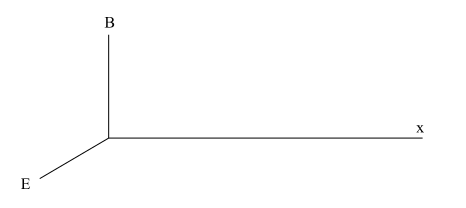Some Background:
I've been trying to understand electromagnetic waves, how they travel, and how they're produced. After some Googling and Wikipedia(ing?) I've learned that we use the EM Wave Equations to model how they propagate. However, every single derivation I've seen online does something like this:
$$\nabla\times{E}=-\frac{\partial_t\mathbf{\vec B}}{\partial t}$$ $$\nabla\times{B}=\frac{1}{c^2}\frac{\partial_t\mathbf{\vec E}}{\partial t}$$
Take the curl of both sides
$$\nabla\times\nabla\times{B}=\nabla\times\frac{1}{c^2}\frac{\partial_t\mathbf{\vec E}}{\partial t}$$
Substitute for $\nabla\times E$
$$-\nabla^2B=\frac{1}{c^2}\frac{\partial_t}{\partial t}(\nabla\times E)=-\frac{1}{c^2}\frac{\partial_t^2\mathbf{\vec B}}{\partial t^2}$$
After a little rearranging, we now have the wave equation describing the magnetic component of the electromagnetic wave...
$$\frac{\partial_t^2\mathbf{\vec B}}{\partial t^2}=c^2\nabla^2B$$
While this derivation is super simple and elegant, because I'm new to this area of math and physics, I don't really understand the physical thought process around each action we take. For example, I can understand curl physically, but the curl of curl is a complete mystery to me.
For this reason, I've been trying to find a different derivation, one that makes it easy to follow the physical thought process behind each step. After a bit of messing around, I think I have something:
The Derivation:
$$\nabla\times{E}=-\frac{\partial_t\mathbf{\vec B}}{\partial t}$$ $$\nabla\times{B}=\frac{1}{c^2}\frac{\partial_t\mathbf{\vec E}}{\partial t}$$
These two of Maxwell's Equations describe the behavior of the electric and magnetic field in 3-D space (with no charges or currents). In general, they say that a changing magnetic field will have an electric field "rotating" or curling around it, and a changing electric field will have a magnetic field curling around it.
Now let's draw a diagram of a situation where we have a changing magnetic field. For simplicity, we'll assume that the magnetic field will only point up (y-direction), the electric field will point out of the screen (z-direction) and the wave will propagate in one dimension only (x-axis):
As a result of these simplifications, we can rewrite the two equations so that movement on the y & z-axis is removed:
Notation of curl ($\nabla\times F)$ according to Wikipedia:
Electric Component:
$$\nabla\times{E}=-\frac{\partial_t\mathbf{\vec B}}{\partial t}$$ Because the magnetic field is increasing only in the y direction, the x & z components of $\nabla\times E$ will be zero:
$$0i + \left(\frac{\partial E_x}{\partial z}-\frac{\partial E_z}{\partial x}\right)j + 0k=-\frac{\partial_t\mathbf{\vec B}}{\partial t}$$
Because we are only considering movement on the x-axis, the term $\frac{\partial E_x}{\partial z}$ is removed and we are left with:
$$0i + \left(-\frac{\partial E_z}{\partial x}\right)j + 0k=-\frac{\partial_t\mathbf{\vec B}}{\partial t}$$
Looking at magnitude only: $$\frac{\partial E_z}{\partial x}=\frac{\partial_t B}{\partial t}$$
We can do the same for $\nabla\times B$ and then we have the two equations in 1-D form: $$\partial E=\frac{\partial_t B}{\partial t}\partial x$$ $$\partial B=\frac{1}{c^2}\frac{\partial_t E}{\partial t}\partial x$$
Let's say that there is a magnetic field at the origin, $B_0$, whose y-component is increasing at a rate of $\frac{\partial_tB_0}{\partial t}$.
The equation: $\partial E=\frac{\partial_t B_0}{\partial t}\partial x$, tells us that as we move an infinitesimal distance on the x-axis ($\partial x$) away from $B_0$, the electric field will increase by $\frac{\partial_t B}{\partial t}\partial x$. Meaning that this increasing magnetic field will induce a perpendicular, increasing, electric field $E_1$ which is equal to $\int{\partial E}$:
The second equation, $\partial B=\frac{1}{c^2}\frac{\partial_t E_1}{\partial t}\partial x$, tells us that this increasing electric field will also induce a magnetic field:
Now we have a nice picture of how the increasing magnetic field induced an increasing electric field and vice-versa. We also have these two equations describing the interaction between the two:
$$\partial E=\frac{\partial_t B_0}{\partial t}\partial x$$ $$\partial B=\frac{1}{c^2}\frac{\partial_t E_1}{\partial t}\partial x$$
Substituting $\int{\partial E}=\int{\frac{\partial_t B_0}{\partial t}\partial x}$ for $E_1$ we get how the magnetic field changes with time:
$$\partial B=\frac{1}{c^2}\frac{\partial_t}{\partial t}\left(\int{\frac{\partial_t B_0}{\partial t}\partial x}\right)\partial x$$
To get the wave equation, we simply take the derivative of both sides, eliminating the integral:
$$\partial^2 B=\frac{1}{c^2}\frac{\partial_t^2 B_0}{\partial t^2}\partial x^2$$ At very small distances, $B = B_0=B_2$, and after a little rearranging, we get the one-dimensional equation describing the magnetic component of the electromagnetic wave.
$$\frac{\partial^2B}{\partial t^2}=c^2 \frac{\partial^2B}{\partial x^2}$$
We can do the same for the electric component: $$\frac{\partial^2E}{\partial t^2}=c^2 \frac{\partial^2E}{\partial x^2}$$
My Question:
Is this derivation/explanation correct? Does it make sense and is the math correct in its steps? If so, is it useful in its explanation or are there other derivations that do a better job at giving an intuitive/conceptual idea of what's happening?
I'm hoping that it is, since although it's long, I feel it gives a nice picture of what is physically happening rather than just performing vector calculus operations on the Maxwell equations. For me, the hardest part was trying to visualize the propogation of EM waves, and every single derivation I saw would just skip the physical explanation and go to the math, which didn't give an intuative explanation. Any input would be greatly appreciated :)





